Governor Cuomo’s Workforce Investment Plan is a Promising Start
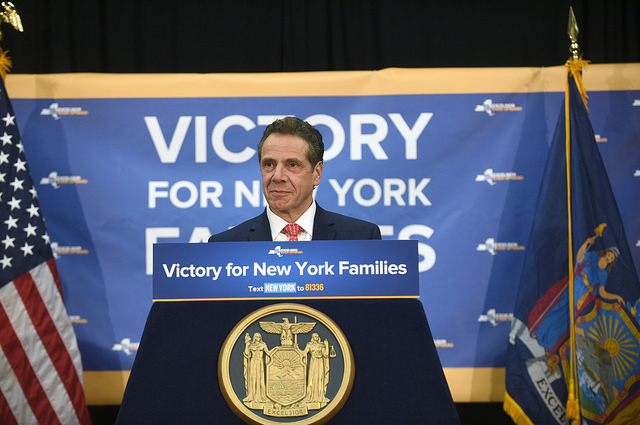
Gov. Cuomo (photo: Kevin P. Coughlin/Governor's Office)
In a time when more and more training and credentialing is necessary to enter the labor market, Governor Cuomo’s workforce development proposal included as part of his 2018 State of the State symbolizes an important recognition that our economy depends on having a skilled and qualified workforce to meet the demands of tomorrow.
The sense of urgency can be found in the realities that today’s young adults are facing in entering the labor market. Seventeen percent of, or 136,000, 18-to-24 year olds in New York City are out of school and out of work. As the economy continues to redefine itself, young adults are increasingly turning to part-time, gig-like employment opportunities to string together income. Many young adults were pushed to earn a college degree—as part of the American rite of passage—only to graduate with tens of thousands of dollars in student debt and entering a labor market with historically low-wages. Consequently, today’s young adults have significantly less income and wealth accumulation than what their parents were making when they were young adults.
The challenges young adults face today are, in part, reflective of the dire need to reimagine how we are preparing young adults to launch their lives with a family-sustaining career. This means ensuring they have equitable access to postsecondary training and credentialing while meeting labor market demand. It’s time for New York State to better leverage its strong and growing economy by building a 21st century workforce development system necessary to adequately prepare rising generations to participate in a constantly changing and increasingly competitive global context.
To be clear, this is not to be confused with the phenomenon of pushing every young person to go straight from high school into a four-year bachelor’s-degree program—although everyone should have access to pursue a college degree if they desire. In fact, according to the Georgetown University Center on Education and the Workforce, 42 percent, or 1.7 million, New York State residents without bachelor’s degrees have good, blue-collar jobs earning an average of $59,000 a year. This directly challenges the mainstream narrative that every young person needs a four-year degree and makes clear the need to invest in a 21st century workforce development system that can help meet the needs of employers in growing industry sectors, without needing a four-year degree.
Governor Cuomo’s proposal to add $175 million to support workforce development efforts, establish a statewide workforce development office, design a data system, and establish a one-stop shop for job seekers and employers is a victory in and of-itself. However, we must remain diligent to ensure his vision becomes the reality New Yorkers need it to be.
The proposed $175 million of funding through the Regional Economic Development Councils is a much needed and timely investment—especially given the rapidly changing nature of the economy. Critical to the success of Governor Cuomo’s bold proposed investment is to ensure that these resources are structurally permanent dollars the workforce, education, and economic development systems can depend on year-to-year in order to adequately train New Yorkers to meet labor market demand.
Because actual funding for the workforce system has declined significantly over the last decade—despite the increasing need for more industry-specific training and credentials—some of the initial resources should be used to build up and modernize the existing workforce development infrastructure. This will allow the workforce development system the opportunity to partner with employers and industry sectors, going beyond their current capacity to create cutting edge, innovative training and skill-development strategies for tomorrow’s workforce.
While Governor Cuomo’s proposal to establish a new State Office of Workforce Development is an important step in the right direction, to be effective, this office must have the authority and capacity to truly facilitate interagency coordination and systems building, and must be adequately resourced as a structural part of the Executive Chamber answerable to the Governor. This office must also be accountable to the New York State Legislature through public oversight hearings and annual reporting to maximize transparency and effectiveness.
Governor Cuomo’s proposal to create a one-stop shop online portal for workers and businesses is a 21st century idea that JobsFirstNYC called for in Unleashing the Economic Power of the 35 Percent, recognizing the fractured and siloed nature of education, training, and employment. If effective, this portal will be a transformative tool that will include job and career information, education and training resources, geographical information on how to find social services related to work, and more.
Finally, Governor Cuomo’s plan to create a statewide data analytics system modeled after Monroe Community College’s framework is a welcomed idea. At first glance, the proposal seems to only focus on the demand side data that is critical to informing where more training and workers are needed to fill skills gaps. However, to be truly comprehensive, this new system must include a universal way to understand and measure programmatic performance that is easy to engage with and will help employers find creative solutions to meet their employment needs. This will ensure that state resources are being used efficiently and help the workforce development adjust its practice accordingly.
As Governor Cuomo and state legislators work to pass the state budget in the coming months, they must ensure that any workforce development strategy empowers local communities to leverage resources that meet the unique need of their economies. Additionally, the state’s workforce development investment must be given the flexibility and infrastructure to create innovative workforce development strategies that are responsive to current demand and can anticipate tomorrow’s evolving needs.
***
Kevin Stump is vice president of Policy, Communications, and In-School Practice for , JobsFirstNYC and Co-Chair of the #InvestinSkillsNY Campaign. On Twitter @KevinStump & @JobsFirstNYC.
***
Have an op-ed idea or submission for Gotham Gazette? Email This email address is being protected from spambots. You need JavaScript enabled to view it.
Celebrating ‘Renewal’ Success as We Acknowledge More Work To Do
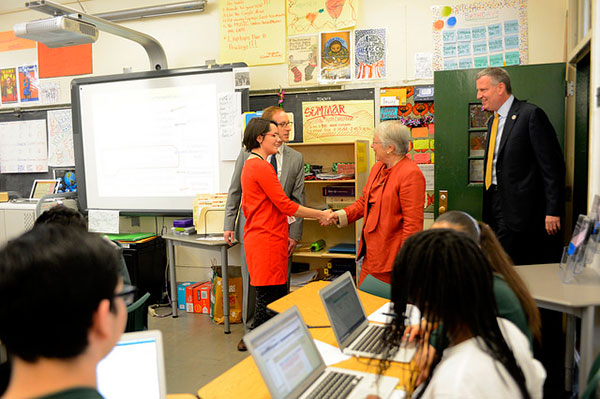
Mayor de Blasio & Chancellor Fariña on a school visit (photo: Rob Bennett/Mayor's Office)
School is back in session after an eventful December and long break. As students returned to our community schools, so many were grateful to be back where supports and resources are in place. For many of our students, community schools provide additional support services; food pantries; mental health and social-emotional learning programs; and family support aligned to what’s happening in the classroom. In other words, they focus on educating the “whole child.”
Coming back to school in the new year feels like a good time to recognize the commitment the city and many nonprofits like mine have made to creating community schools. And, three years into the Renewal School program— the largest school turnaround effort in New York City’s history, which has a two-pronged strategy: the infusion of a strong instructional core and the conversion of every school into a community school—it’s time to look at the results. Each Renewal School has a non-profit partner to lead its transformation into a community school; the goal is to bring together the expertise of educators and community partners to make improvements across all the areas schools need to succeed.
My organization, Partnership with Children, is a partner in nine Renewal Schools, and we are proud that two of them – Renaissance School of the Arts in East Harlem and P.S. 67 in Fort Greene – have made steady progress and will transition out of the Renewal program to become “Rise Schools.” As we evaluate the potential of the investments made in Renewal Schools, we need to recognize the success of these schools and others like them.
Renaissance School of the Arts is exemplary because it has the right people and resources in place, thanks in large part to its Renewal School status. The school leadership and faculty are strong and have implemented new cutting-edge teacher training. Partnership with Children’s social work team has provided counseling, a parent support group, and social-emotional learning workshops. By working together, Renaissance and Partnership with Children have established a flourishing school culture where a strong student voice is developing, both in and out of the classroom. You see it in an active student government, a student-run school store, and even the way students communicate and support their ideas when interacting with adults.
Attendance is at 95% so far this year, up from 89% for the 2013-14 school year. Since 2014, the percentage of students proficient in English Language Arts (ELA) has increased 17 points and the percentage of students proficient in math has increased 13 points. There is need for more improvement, but the model is working at Renaissance.
We also have an excellent partnership at P.S. 67 with the ambitious and impressive principal and her dedicated team. Partnership with Children staff are in the school building before, during, and after the school day – and on the weekends and during the summer – working side-by-side with the principal. Parents stay after drop-off and pick-up to meet with guidance counselors and social workers, teachers are eager and faculty retention is increasing, and student outcomes are improving. Proficiency in ELA has improved 20 percentage points; in math, 10 points. This is what happens when everyone in a school building puts their resources, experience, and heads together.
The students, faculty, staff and leaders at both of these schools are ambitious and aligned, and that is part of what helped them make gains that other Renewal Schools have struggled to make. They’ve broken down silos and gotten all the adults in the school community on the same page. Data absolutely drives their work.
In light of the news about the schools that are closing, I urge us not to overlook the success of schools like Renaissance and P.S. 67, and the others moving from Renewal to Rise Schools. It should inspire us to re-commit to this radical transformation of schools – not pull back from that call to action. The DOE has committed to continuing the Community Schools partnerships and investments in educating the whole child in the 21 new Rise Schools—those that have met their benchmarks, including Renaissance and P.S. 67. And it is also responsibly making the difficult decision to close the schools that are farthest off their benchmarks.
Programs are always politicized, but let’s not let our children be. I applaud the commitment of the DOE, the City, and our fellow community-based organizations to take on the challenges of these schools – underperforming and under-resourced for decades – at an unprecedented scale.
***
Margaret Crotty is the executive director of Partnership with Children. On Twitter @PWCNYC.
***
Have an op-ed idea or submission for Gotham Gazette? Email This email address is being protected from spambots. You need JavaScript enabled to view it.
Our School Governance Isn’t Working, and It’s the Perfect Time for Change
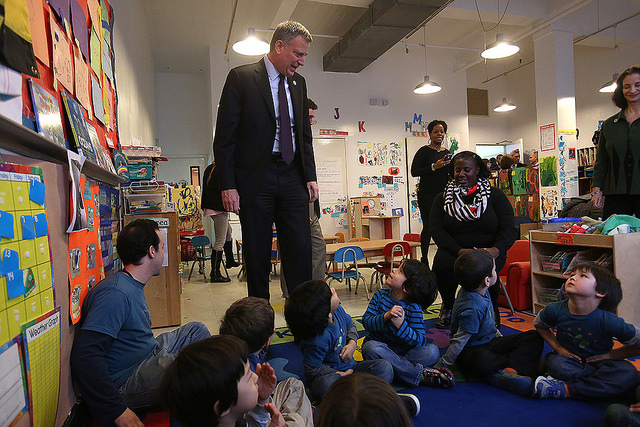
Mayor de Blasio visits a school (photo: Rob Bennett/Mayor's Office)
With the announcement that Carmen Fariña will retire in early this new year, Mayor de Blasio has an opportunity to improve the way that New York City public schools are governed, and he should take this chance.
Many New Yorkers have lost their patience with the mayor on this important issue. In addition to Fariña’s retirement news, we learned just one day earlier that the DOE spent a mind-blowing 600 million taxpayer dollars to improve just 94 struggling schools over three years. Only 21 schools improved enough to shed the label, despite $2 million per year per school, on top of regular school funding! Tangible results are hard to find at the Renewal Schools, de Blasio’s signature school improvement program.
Further, thousands of Renewal Schools children, their parents, and hard-working teachers all around the city also learned that their educational futures would abruptly change via a cornucopia of closures, mergers, and truncations upon which the mayor’s Panel for Educational Policy will vote.
In District 3’s Harlem neighborhoods, where two such Renewal Schools exist, one of them is being punished while the other gets another year to show progress. Our elected council of parent keeps asking for answers to contradictions like these and keeps finding a common problem: mayoral control of city schools without mayoral responsibility.
The most recent two-year extension of mayoral control in Albany was hailed as a victory for school governance, but it was, as usual, peppered with backroom deals allowing recycling of revoked charters and increasing the city’s financial obligations for charter school operations. In the weeks prior to the deal, advocates for mayoral control painted a bleak picture of what would befall New York City children if Albany failed to extend it.
But a simple question remains unanswered – indeed, unasked – from the original mayoral control debate under Mayor Bloomberg: If the mayor has control, for what are the mayor, the schools chancellor, and district superintendents responsible beyond daily operations and basic accountability for the overall system?
As the elected parent leaders of Community District 3 in Manhattan, we consider this question urgent. Many districts suffer from the question of local accountability; there can be circular finger-pointing among superintendents, principals, and the DOE. Many of the school communities we represent face a crisis not of their own making and for which the Department of Education has taken little responsibility.
In the northernmost part of our district, zoned elementary schools have seen a drop in their enrollment of a full third in the past decade. Leadership under successive mayors has not led to a dramatic renewal of these public schools, but a systematic hollowing out of their enrollment and place in our community.
This is not accidental. Under Mayor Bloomberg, charter schools proliferated through cooperation between his office and charter-friendly politicians in Albany. Today, parents across the city face a wide array of school options, but choice has ballooned in geographic clusters that correlate directly with racially segregated neighborhoods. In District 3’s Harlem neighborhoods, just 36 city blocks, parents send their children to more than 60 different school options inside and outside of the district.
District 3 is not even the most impacted by this failing governance structure. In the South Bronx and all over Brooklyn, public school leaders, parents, and other stakeholders face the same conundrum.
School choice was promised to improve all of our schools through competition, but the results have been far from that. In fact, the lack of transparency surrounding charter schools makes it almost impossible for school districts to predict enrollment, manage their administrations, and develop long term plans. We essentially have a de facto two-school system Department of Education, and that must end.
Across the city, zoned schools in heavily chartered neighborhoods have higher percentages of high-needs children than a decade ago; far higher, in fact, than the surrounding charter schools. Furthermore, district schools are left to “compete” in this complex environment with no assistance from the Department of Education, which leaves principals to “market” themselves with whatever they can shoestring together from already overstretched budgets.
Meanwhile, charter networks such as Success Academy spend lavishly on marketing consultants and direct mail campaigns to attract applicants. And they deliver this marketing via third party transactions that tap into student and family residential information that the DOE licenses, yet won’t provide to traditional public schools for the same purpose. The playing field to compete for students is not level, and nobody in the mayor’s office or DOE is taking responsibility for it, preferring to leverage dwindling enrollments by school mergers, closures, and truncations without looking at key underlying problems.
And the promised systemic improvements to all of our schools? It is nowhere to be seen.
While some charter networks boast high test scores, many do so by employing methods that would never be tolerated in our city’s high-performing schools largely attended by middle and upper middle class families.
Former Mayor Michael Bloomberg bragged in March 2012 to a panel in Washington, D.C. that his policies had cut the achievement gap between white students and students of color in half. However, using data from the National Assessment of Educational Progress (NAEP) and from New York’s state exams, Dr. Aaron Pallas of Teachers College demonstrated that between 2003, just before Mayor Bloomberg’s reforms had been implemented, and 2011, the achievement gap demonstrated by the NAEP actually rose and the gap measured by state exams closed by a mere 1%.
Mayor de Blasio, not an ally of charter schools, did not initiate this problem, but he does own it. That is the meaning of mayoral control. It is about the roots of school governance, school choice, and school quality.
The parents in District 3 are tired of this situation. If the mayor is going to have control of our schools, then his office needs to engage in a serious, respectful, and sustained conversation with our community about what we truly need so that all our district schools are places where all children thrive. Moreover, he needs to take responsibility for helping them compete in the slick, professional marketing environment in which they exist. This cannot wait for another two years when Albany will go through yet another staged drama at our children’s expense, considering the new terms of extending mayoral control.
The search for the new New York City schools chancellor should factor in these critical issues as well. Before the mayor replaces Chancellor Fariña, we ask that he taps into our collective expertise. We need an educator, with a vision that will permeate to superintendents, an adroit manager, and someone who is willing to go deep into the structure for changes that will heal gaping fissures in the organization. New York City children deserve it.
***
by members of the District 3 Community Education Council
Kristen Berger; Manuel Casanova; Inyanga Collins; Daniel Katz; Lucas Liu; Michael McCarthy; Genisha Metcalf; Jean Moreland; Dennis Morgan; Yan Sun; and Kimberly Watkins (President).
***
Have an op-ed idea or submission for Gotham Gazette? Email This email address is being protected from spambots. You need JavaScript enabled to view it.
How Bill de Blasio Can Redeem His Education Record
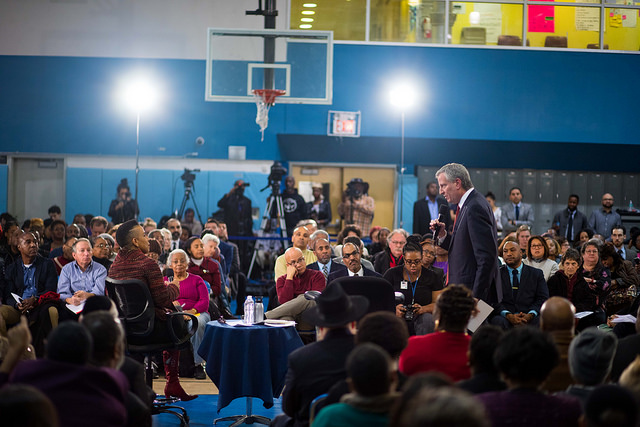
Mayor de Blasio at a town hall (photo: Benjamin Kanter/Mayor's Office)
Bill de Blasio was re-elected as mayor and will remain in control of our public schools for four more years, unless the Legislature amends mayoral control or allows it to expire in 2019. It was recently announced that Carmen Fariña, de Blasio’s hand-picked schools chancellor, will be leaving and a “national search” has begun to find her replacement. We urge the mayor to involve the public in the selection process, as he promised during his first campaign but failed to follow through on when selecting Fariña.
Instead, he apparently plans a “quiet internal decision.” Yet by opening up the process, he would have the benefit of a wider choice of candidates, and by involving parents, he would be better able to ensure that the next chancellor is more responsive to their concerns.
One of us is a long-time parent advocate and the other is the former president of the Community Education Council in District 2 in Manhattan – although what we say here only represents our own personal views. We are also members of NYC Kids PAC, which released a mayoral report card this fall, in which we gave de Blasio and his chancellor low grades in many education areas, surprising city residents who do not have children in the public schools. The reasons are myriad.
The mayor continues to underfund our schools, and most schools still receive only 87% of the amount promised when the Fair Student Funding formula was devised ten years ago, despite increased costs and repeated city surpluses. This underfunding has contributed to larger classes and inadequate services at many schools. Meanwhile, the number of top-level administrators has nearly doubled, with 70% more spent on central staff bureaucracy than during the last year of the Bloomberg administration, and with 34% more spent on central staff expenses.
The mayor renounced his earlier campaign promise to parents to lower class size, and the chancellor repeatedly stated in public meetings that she has been more concerned that classes can be too small -- despite the fact that New York City students continue to suffer from the largest classes in the state. The number of students in grades one to three in classes of 30 or more has increased by nearly 3,800 percent since 2007 and more than 290,000 students -- nearly one-third of the total -- are crammed into classes this large. The city’s refusal to act to lower class size prompted a legal complaint against the DOE, filed with the State Education Department this summer.
Meanwhile, more than half a million students are currently attending overcrowded schools.
With the student population growing in many parts of the city, the school capital plan will create only about half the seats required to alleviate overcrowding, according to the DOE’s own estimates. And while Mayor de Blasio has delivered on his promise to expand pre-kindergarten, the administration has pushed the program into many schools where it worsened overcrowding and contributed to larger class sizes. As more than 73 professors of education and psychology pointed out in a letter to the Chancellor Fariña, many of the benefits of expanded pre-K will likely be undermined because of the administration’s refusal to address the need to lower class size in other grades.
Forty million dollars per year has been spent on consultants and bureaucrats to oversee the struggling schools in the Renewal program, many with records marked by scandal or found to be incompetent in previous positions. Though the DOE made special promises to the state to reduce class size in these schools, nearly three-quarters continue to have maximum class sizes of 30 or more; and in nearly half, average class sizes have not decreased by even one student. It is no surprise that by most accounts, improvements in these schools have not been impressive, with one-third facing or having already experienced merger or closure.
Too often the chancellor has left administrators in positions where they have abused their authority. It took nearly a year of intense student protests before Rosemarie Jahoda, the acting principal at Townsend Harris High School, was removed, even after nearly every local Queens elected official asked for her dismissal. Chancellor Fariña was also deaf to the entreaties of parents at Central Park East 1 for over a year. They pointed out how their principal was violating the progressive and collaborative traditions of the school. In other instances, the chancellor left corrupt principals in place when they engaged in rampant fraud, including Kathleen Elvin, who remained the principal at John Dewey High School for nearly two years, despite numerous news reports exposing her schemes to inflate the school’s graduation rate.
While running for office, Mayor de Blasio promised to lessen high stakes testing and make school admissions based on more holistic factors. Yet in 28 out of 32 districts, admissions to gifted programs are still based solely on a single high-stakes exam. The same is true for admissions to the eight specialized high schools, even in the five schools where this is under the mayor’s sole control; and too many other middle and high schools continue to use test scores as central factors in their screening process.
Though de Blasio also promised to “develop a non-punitive process” to allow parents to opt their children out of standardized testing, the chancellor has failed to respect the resolution passed by the City Council which calls upon the DOE to include information about this in its Parent's Bill of Rights.
For many of us, the realization that New York City is one of the most segregated public school systems in the nation was appalling, and yet Chancellor Fariña suggested that this problem could be addressed by encouraging wealthy students to become pen pals with poor students in other public schools. After much public pressure, the mayor and the chancellor finally released a diversity plan last spring, yet an analysis by the Center for New York City Affairs found that its goals were so weak they could be met if current demographic trends continue -- without any actions taken.
The Panel for Educational Policy, made up of a supermajority of mayoral appointees, is still largely a rubber stamp when it comes to approving excessive contracts and damaging co-locations and school closings. The recommendations of parents and teachers on School Leadership Teams are usually ignored, as is the input of parent-led Community Education Councils.
The DOE also suffers from a lack of transparency, and is the least responsive of city agencies when it comes to fulfilling Freedom of Information requests -- taking an average of 103 days to respond. The chancellor insisted on closing meetings of School Leadership Teams, even when a decision by the State Supreme Court concluded that these meetings must be open to the public. She only conceded when the Appellate Court ordered her to reverse course in a unanimous decision.
When he took office, Mayor de Blasio promised to listen to parents and community members rather than treat the Department of Education as his personal fiefdom. Chancellor Fariña announced she would take a new direction based on a “Framework of Great Schools,” involving collaboration and trust among parents, teachers, and administrators. Yet too often that sense of trust has been broken, and the mayor and chancellor have exhibited a regrettable lack of regard for parent views.
We urge the mayor to involve the public in the vetting process for a new chancellor, as he had previously said should be the case. He should announce how individuals can apply for the position, and allow parents and other citizens to ask questions of leading candidates and provide feedback on their responses. In this way, he might be able to redeem his record and raise the chances that our next chancellor will partner with parents and community members to focus on the critical problems that are crying out to be addressed in our schools.
***
Leonie Haimson is the Executive Director of Class Size Matters and Shino Tanikawa is the President of NYC Kids PAC.
***
Have an op-ed idea or submission for Gotham Gazette? Email This email address is being protected from spambots. You need JavaScript enabled to view it.
Contrary to Cuomo Claim, Upstate Economy Faltered This Century, Not Last
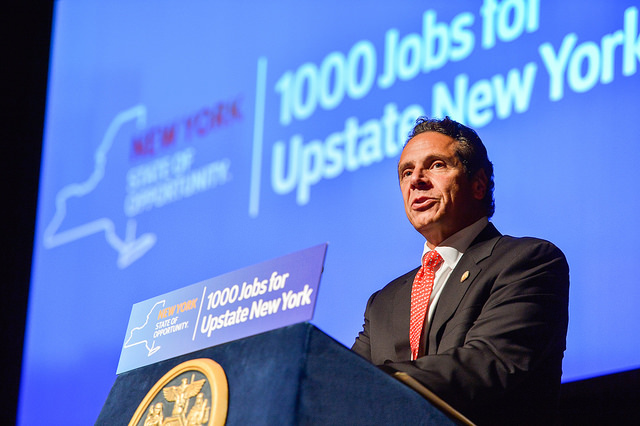
Gov. Cuomo upstate (photo: The Governor's Office)
Governor Cuomo described the Upstate New York economy as suffering from a “bad 50 years “ as he tried to explain why it was hard to stimulate rapid growth in the region’s economy, which has grown far more slowly than the rest of the state and nation (see my prior column: Upstate New York is Home to Heavy Voter Turnout, Major State Investment, and Minimal Job Growth).
Cuomo also said that his administration had changed the trajectory upward. Residents of the state should be concerned about how successful these efforts are: Upstate York has more than a third of the state’s residents and is nearly 50 percent of the vote in gubernatorial elections; the state has enacted intensive programming to uplift that region’s economy, and the state must make major decisions about the allocations of its resources and assets every year and set policy directions.
When I wrote the earlier column, I assumed the governor’s description of Upstate’s economic decline was generally true. But in the course of verifying the accuracy of the 50-year decline claim in order to elaborate on the issue, I learned that it was not true.
The Upstate New York economy only slowed to a crawl in the years after 2000, largely due to the two recessions that occurred between 2000 and 2010. This major slowdown did, of course, occur before Andrew Cuomo became governor in January 2011. But a detailed look at the history of the state’s economy and employment growth shows that Upstate New York’s employment growth actually outpaced the rest of the state in the 1980s, and continued a moderate climb forward in the 1990s, although both regions grew more slowly than the rest of the nation. Employment grew 20% in each of the two decades across the United States.
New York State Labor Department figures show Upstate employment growing at 17% in the ‘80s, versus 12% Downstate (1). Downstate consists of New York City, Nassau, Suffolk, Westchester, Rockland, and Orange counties (2). Upstate is the remainder of the state.
|
NYS EMPLOYMENT GROWTH, 1980-90, NY AND REGIONS (000) |
||||
|
1980 |
1990 |
Growth % |
||
|
NYS |
7113 |
8098 |
13.8% |
|
|
Downstate |
4645 |
5206 |
12.1% |
|
|
Upstate |
2468 |
2892 |
17.2% |
|
Governor Cuomo seemingly was expressing a public perception that manufacturing job loss broke the back of the Upstate economy decades ago. Manufacturing job loss has in fact been relentless, in Upstate New York and Downstate New York, and the nation as a whole. In 1979 the United States reached its peak manufacturing employment with 19.5 million jobs. New York’s manufacturing employment history since then, divided between the regions:
|
NYS MANUFACTURING EMPLOYMENT, 1979-90(1),1990-2010(1) (there are two figures for 1990, see footnote (1) below) |
|||||
|
1979 |
1990 |
1990 |
2000 |
2010 |
|
|
Upstate(000) |
707 |
574 |
513 |
421 |
276 |
|
Downstate(000) |
787 |
557 |
468 |
328 |
181 |
In 1979-80, manufacturing jobs were 29% of Upstate New York employment, and 17% Downstate. Manufacturing job losses were seriously affecting employment in New York, but in the 50-year lookback to the late ‘60s and ‘70s, it was New York City’s economy that was in freefall in the early ‘70s. New York City lost 600,000 jobs, including 300,000 manufacturing jobs, from 1969 to 1976 (according to the Federal Reserve Board of New York, quarterly review, summer 1977). But the city economy recovered in 1977 and beyond.
Two recessions, in 1980 and ‘81-’82, hit the steel and auto industries in Western New York hard. The huge Bethlehem Steel plant in Erie County closed in 1982. Erie and Niagara Counties lost 41,000 manufacturing jobs from 1979-85. IBM and Kodak began their manufacturing job declines in the mid-to-late ‘80s and continued through the ‘90s. Despite these cutbacks, the Upstate economy as a whole still continued to expand once the recessions were over and grew by more than 400,000 jobs in the ‘80s.
In the 1990s, both regions saw their employment grow at a pace of about 5% for the decade, including the severe recession of the early ‘90s. In 1990, manufacturing was still 18% of Upstate employment but had fallen to 9% Downstate, meaning Downstate’s transformation to a service-based economy had effectively been completed. After the recession was over, the Downstate area did grow more rapidly, but Upstate employment growth still gained over 200,000 jobs and had 7.4% growth over a seven-year period.
|
NYS EMPLOYMENT GROWTH, 1990-93-2000, NY AND REGIONS |
||||||
|
1990 |
1993 |
2000 |
1990-2000 |
1993-2000 |
||
|
NYS |
8203 |
7750 |
8624 |
5.10% |
11.30% |
|
|
Downstate |
5319 |
4941 |
5606 |
5.40% |
13.50% |
|
|
Upstate |
2884 |
2809 |
3018 |
4.60% |
7.40% |
|
Foreign immigration, especially into New York City, began to make a major difference in population growth in the two regions in the 1990s. According to New York City Planning reports, the city gained 800,000 foreign immigrants in the ‘90s .This gain in the City, where two-thirds of the Downstate population lives, roughly mirrored the 800,000 person growth in population in that decade for the Downstate region. Between 2000 and 2015 the city gained another 340,000 foreign immigrants and Downstate gained another 425,000 persons. Between 1990 and 2016 Downstate gained more than 1.6 million people and more than 14% increase in population. Upstate New York gained only 2% in population. With population growth comes new demand for goods and services and employment gains.
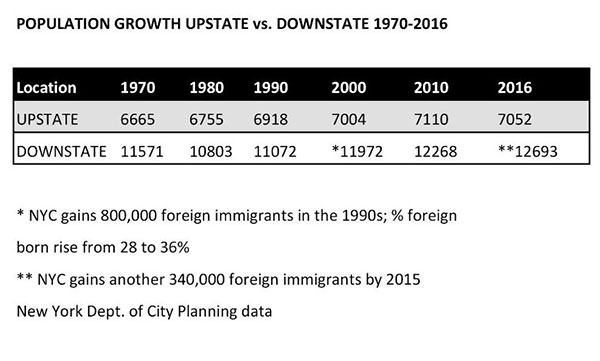
By 2000 manufacturing employment was 14% of employment in Upstate New York and only 6% Downstate. The United States entered another recession in 2001 and employment actually declined for two years, including a loss of 2 million manufacturing jobs. The terrorist attack that destroyed the Twin Towers and killed thousands also had significant effects on employment in New York beyond the impact of the recession.
After the recession ended employment in the Downstate region grew rapidly until 2008. But the growth rates of the two regions differed sharply, with Upstate growing only 1.7% in the five years versus 6.1% in the Downstate region, when the Great Recession hit New York and the nation. New York City’s economy took off after the Recession, but Upstate New York had lost another 145,000 manufacturing jobs in the decade, more than a third of its remaining factory jobs from 2000. By 2010, Upstate New York had fewer jobs than it did in 2000.
The Upstate economy had a very bad ten years, from 2000 to 2010, and the manufacturing and other job losses during this period truly shook the base of the Upstate economy.
Employment
|
2000 |
2003 |
2008 |
2010 |
Growth 2003-2008 |
Growth 2000-2010 |
|||
|
NYS |
8624 |
8395 |
8777 |
8544 |
4.6% |
-0.9% |
||
|
Downstate |
5606 |
5434 |
5765 |
5622 |
6.1% |
0.3% |
||
|
Upstate |
3018 |
2961 |
3012 |
2922 |
1.7% |
-3.2% |
||
The past column reported that Upstate private sector economic growth from 2010 to 2016 was 5.8%, with slightly faster growth in the bigger metro areas like Albany, Buffalo, and Rochester, but weak-to-no growth in other areas. How and where the state government is allocating its resources and assets will be the subject of the next column, along with a continued look at its economic development policies and overall strategic efforts to leverage meaningful improvement in the Upstate economy.
[Read: Upstate is Home to Heavy Voter Turnout, Major State Investment and Minimal Job Growth]
(1) Older historical employment data contained different employment classification systems, that mixed proprietors and payroll together, among other differences, so the series used for 1980-1990, and for manufacturing from 1979 to 1990, is not comparable to a later 1990 base that uses only payroll employment coming forward from that time.
(2) The New York State Labor Department metro area employment data places Orange County in a Westchester-Rockland-Orange region, so Orange County is counted in Downstate employment.
***
Jim Brennan was a member of the New York State Assembly for 32 years, where he chaired four committees. On Twitter @JimBrennanNY.
***
Have an op-ed idea or submission for Gotham Gazette? Email This email address is being protected from spambots. You need JavaScript enabled to view it.
Trump Administration’s Edict to CDC Puts Millions of Lives at Risk
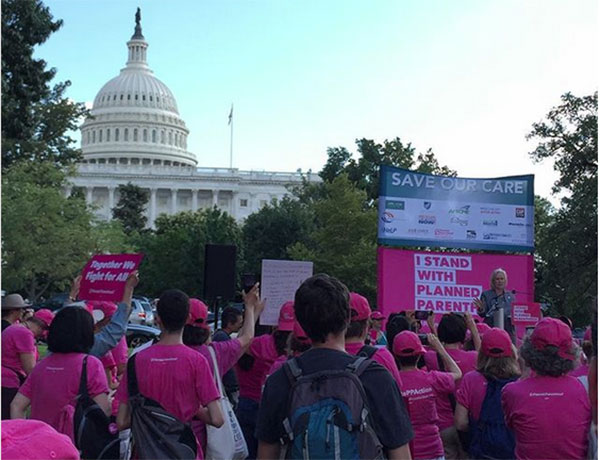
The Washington Post recently reported that, in an unprecedented and dangerous move, the Trump-Pence administration has banned the Centers for Disease Control and Prevention (CDC) from using seven key words and phrases: “evidence-based,” “science-based,” “transgender,” “fetus,” “vulnerable,” “entitlement,” and “diversity.”
As a health care provider committed to fighting health disparities and caring for everyone who comes through our doors, we are horrified by these reports. This is dangerously ideological, and will put the health and well-being of millions at risk.
It’s not just about these seven terms. The Trump-Pence administration is trying to make a radical change in the focus of the entire agency—pushing a science- and evidence-based agency to one seeking to advance extreme ideology. The CDC is a non-partisan, non-ideological federal agency charged with scientific research and improving and protecting public health. This move is a direct contradiction to the pledge the agency has made to the American people.
This is just one more attempt by the Trump-Pence administration to prioritize a fact-free, ideological agenda over people’s health. From day one, this administration has shown a complete disdain for women, LGBTQ people, people of color, and science—from the policies they’ve enacted to the people they have put in charge of important programs. This effort further reveals their agenda: using the federal government to push harmful, politically driven policies at the expense of science and medicine.
This is only the latest of a long string of dangerous policies and rhetoric coming out of the Trump-Pence administration. Just a few weeks before this, Trump decided that reliable birth control methods should be replaced with the “calendar method,” which fails nearly a quarter of those who use it every year.
It’s clear that this administration is attempting to infiltrate all areas and agencies of government—and of our private lives—with their harmful ideologies. And it’s not just the administration. Under House Speaker Paul Ryan’s leadership, the House has worked tirelessly to restrict access to sex education, birth control, and abortion. In fact, when recently discussing the GOP tax cut plan, Speaker Ryan proclaimed that women need to have more babies.
The edict to the CDC is an affront to women, to transgender people, and to all communities that experience health disparities—this is an affront to the patients that we serve every day in New York City and elsewhere. It’s also an affront to the professionals who work at the CDC, to the science and medical communities whose work will be deeply affected, and to anyone who has benefited from scientific research or medicine in the United States and around the world.
The Trump administration is using the federal government to try and control women’s bodies and erase LGBTQ people and people of color. This goes directly against the will and values of New Yorkers—and of Americans—and we will not stand by and let this happen.
This move is beyond ideologically twisted, and will put millions of lives in danger, including our patients’. The Trump-Pence administration should be ashamed, and must end this dictate immediately.
***
Laura McQuade is President and CEO of Planned Parenthood of New York City.
***
Have an op-ed idea or submission for Gotham Gazette? Email This email address is being protected from spambots. You need JavaScript enabled to view it.
The Airbnb Reality in Central Brooklyn
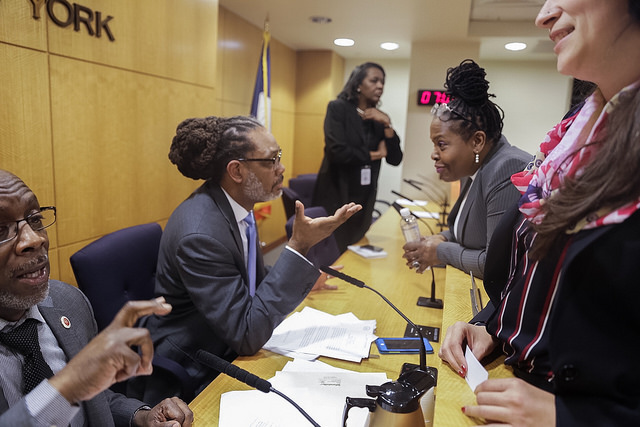
City Council Member Robert Cornegy (photo: William Alatriste)
Just when I thought I’d seen it all, here comes Michael McKee with a screed against middle class home sharers like me that would -- or at least should -- make the hotel industry blush. From one New Yorker to another - thanks but no thanks. We don’t need a white “savior” to tell people of color that they know how to best address gentrification in their communities.
I am a third generation Bedford-Stuyvesant resident, mother of three, and a proud constituent of City Council Member Robert Cornegy, Jr. For years, I’ve shared my home with travelers from all over the world -- introducing people to my favorite local businesses and generating some extra income to provide for my family.
Hosting through Airbnb helps me pay my property taxes, contribute to my children’s education, and stay in the home and neighborhood I love, so that one day I can pass it on to my children.
In his op-ed, McKee uses desperate attacks filled with debunked reports and misleading data to explain his misinformed view of why home sharing “doesn’t work.” He asserts that "75 percent of Airbnb revenue in New York City is generated by commercial hosts with multiple listings, not ‘regular folks’ renting their own place.” This is false.
In reality, 95 percent of New York City hosts who share an entire space have a single listing and 88 percent of host earnings in the city come from guest stays in private and shared spaces (i.e. a spare bedroom), long-term stays lasting at least 30 days, and short-term stays with hosts who have only one entire home listing.
This data can easily be found in Airbnb’s monthly data releases, but it’s pretty clear that McKee has no use for facts.
Indeed, he claims, without evidence, that "North and Central Brooklyn are the epicenter of gentrification in New York City, and Airbnb has played a destructive role.” Nothing could be further from the truth. In fact, Airbnb is helping families like mine stay in our communities. Home sharing is a bulwark against gentrification and the rising cost of living. Seventy-nine percent of Airbnb hosts in New York City report that home sharing has helped them stay in their homes, with 30 percent saying it’s helped them avoid eviction or foreclosure.
Moreover, rents in many Brooklyn neighborhoods were rising far before Airbnb came to town. According to MNS monthly reports, the average 1-bedroom in Williamsburg in January 2011 -- when Airbnb was still in its infancy -- cost $2,979 a month. In October 2017, the figure was $2,946, a decrease over the period of Airbnb's greatest growth.
The sad truth for a proud organization like Tenants PAC is that its leader, Mr. McKee, sounds more like a mouthpiece for the big hotel industry than he does an ally of tenants and homeowners.
It’s outrageous for McKee, who lives in a pre-war condo in Chelsea, where two-bedroom units sell for over $1 million and one-bedrooms rent for more than $4,000, to point his finger at New Yorkers like me as the cause of gentrification in our own neighborhoods. It's even more ridiculous when he cites an offensive, completely flawed "study" by an opponent of home sharing that was torn apart by actual academics.
Instead of parroting specious arguments made by the hotel industry, which continues to bulldoze permanent housing to build luxury hotels in New York City, even as profits stand at all-time highs, true advocates for tenants should get behind a bill introduced by Brooklyn Assemblymember Joe Lentol, A-7520, which would ensure that New Yorkers could share their own home, while protecting affordable housing from bad actors who threaten to remove permanent tenants.
The bill creates a mandatory registration system for hosts and would allow Airbnb to collect nearly $100 million in lodging/sales taxes in the first year alone. That’s money that could be used for affordable housing, as in Portland, Oregon and New Orleans, or services for people without homes, as in Chicago and Los Angeles.
You don’t have to look at Census data to realize that there are more white folks and fewer black folks here than there were 10 years ago. Bed-Stuy isn’t static -- no neighborhood ever is. But families like mine that have invested blood, sweat, and tears into this community for generations are going to do whatever we can -- including hosting through Airbnb -- to keep a toehold in the place we call home. Maybe Michael McKee should swing by sometime and see what we’re all about.
***
Richelle Burnett is Airbnb host who lives in Bedford-Stuyvesant.
***
Have an op-ed idea or submission for Gotham Gazette? Email This email address is being protected from spambots. You need JavaScript enabled to view it.
Stop the Yeshiva Madness
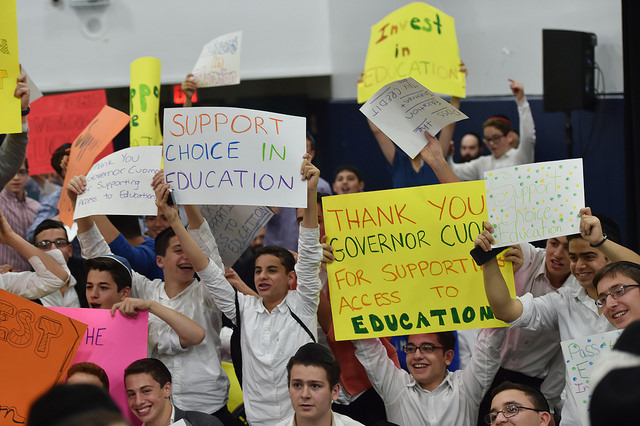
(photo: Office of the Governor - Kevin P. Coughlin)
In recent weeks, the distortions and misinformation about the education our yeshivas provide to our students has grown exponentially. The absurdity hit a new high two weeks ago, when David Bloomfield argued in a Gotham Gazette op-ed that Mayor de Blasio and other elected officials could face arrest over the issue.
Two years ago, a former yeshiva student sent a short letter to the city’s Department of Education alleging that some 30 yeshivas did not offer any secular studies or any instruction in English. This, he said, ran afoul of a state requirement that private schools provide “substantially equivalency of instruction” to its students.
Yeshivas are religious schools whose goals and philosophy differ from public schools – and from one another. Bloomfield has spent much of his career at public institutions, so it is not surprising that he has some fundamental misunderstanding of yeshivas. There are more than 275 yeshivas in this city and they are as different from one another as they are similar.
Our yeshivas educate more than 110,000 students annually, and so it is also not surprising that some graduates are disaffected critics. But if Bloomfield is to be taken seriously, he can’t analyze by anecdote or use his lack of knowledge about our schools to spread innuendo.
Bloomfield probably teaches several dozen students a year, yet I’m sure he wouldn’t think it fair to be judged by those who thought his class was a waste of time. Yet Bloomfield has no problem judging a system of 275 independent schools with more than 100,000 students by a handful of dissatisfied alumni.
These critics released a deeply flawed, though widely-quoted, report asserting that our students aren’t learning, and that our graduates aren’t prepared for the workforce. Few if any of those who have cited the report have looked at it closely. If they did, they would realize that its methodology is more Survey Monkey than scholarship – it was based on a survey completed by 50 supposed yeshiva graduates who are Facebook friends with the author of the complaint letter to the City.
The report’s distortions were insulting to the thousands of families who send their children to yeshivas each day. We are enormously proud of the education our yeshivas provide. Our students attend school for 12 hours every day – a strikingly longer school day than required by most other districts. Yes, much of the day is devoted to study of Jewish law, consistent with a tradition stretching back a century. But our classrooms are filled with intellectual debate and academic rigor more common to colleges than middle schools. Our students are taught to analyze facts, debate ideas, challenge assumptions, and think critically. Our attendance and graduation rates exceed those of the public schools. Our graduates are integral to the fabric of our city’s economic life.
While Bloomfield is quick to reach snap conclusions about the mayor and yeshivas, he has much less to say about the performance of public school students. Let’s start with English Language Learners – those students for whom English is not the first language, similar to many Chasidic school students – in Brooklyn public schools. Bloomfield focuses on the performance of ELLs in Chasidic yeshivas but has nothing to say about the proficiency of ELLs in proximate public schools. That's a shame, because the performance results of ELLs on state-mandated tests for Districts 14 and 20 - where the vast majority of the yeshivas subject to the original complaint are located – are depressing. For most subjects and grade, the proficiency rate is in the single digits. Substantial equivalence indeed!
Yeshivas can surely improve, but ultimately parents must have the right to choose how their children are educated. Every year, thousands of parents choose to send their children to yeshivas both for their unique curriculum and to avoid the failures of a public school system about which they have no desire to be “substantially equivalent.”
It is far easier to criticize than to understand. If critics want to be taken seriously by the institutions they hope to impact, they need to demonstrate a deeper understanding of the values that have helped yeshivas thrive, and they must refrain from defining a multi-faceted system of 275 schools and 100,000 students by what they perceive to be the weakest few schools and students.
***
Avi Greenstein is the Executive Director of the Boro Park Jewish Community Council, a member of the executive committee of PEARLS, and a former principal at Yeshiva Imrei Yosef.
***
Have an op-ed idea or submission for Gotham Gazette? Email This email address is being protected from spambots. You need JavaScript enabled to view it.
Right to Know Act: Progress and Disappointment
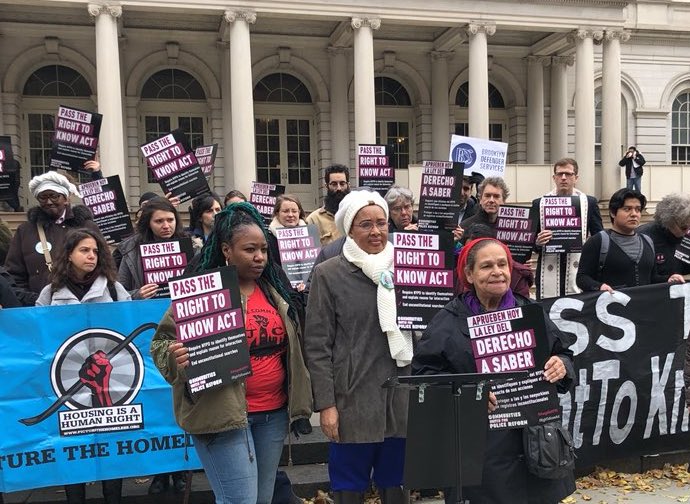
On Tuesday, the New York City Council passed two police reform bills. One marks a vital step toward police reform and accountability. The other takes our city in the wrong direction.
First the good news: a consent to search bill, sponsored by Council Member Antonio Reynoso, passed with support from over 200 community organizations, including the families of New Yorkers killed by police, and organizations led by homeless, LGBTQ, undocumented, and formerly incarcerated New Yorkers, and black and Latino youth. The bill will require the NYPD to create a policy directive that mandates that police officers notify New Yorkers of their right to refuse a search if the officer does not have probable cause to search them.
The NYPD will also have to document proof of consent, and ensure translation if necessary, so all New Yorkers comprehend it is their constitutional right to refuse searches without probable cause. It is a common sense and long overdue reform that will enhance accountability measures and increase protections for New Yorkers during interactions with officers.
The second bill, sponsored by Council Member Ritchie Torres, was opposed by over 200 community organizations, all five public defender offices, 100 Blacks in Law Enforcement Who Care, the National Latino Officers Association, and the Grand Council of Guardians. This legislation, known as the police identification bill, will in some situations require police officers to provide New Yorkers with a business card identifying the officer and an explanation for the stop.
As with consent to search, community members had pushed for such legislation for years. But inexplicably, because of last-minute changes, the final bill intentionally excludes traffic stops as well as the majority of non-arrest street encounters with police officers. It also includes a broad exception that significantly limits the NYPD’s responsibility to provide New Yorkers with an explanation for why they are being stopped.
Here’s what the holes in the final police identification bill mean in practice. If a young person is coming home from school and an officer asks him, “what are you doing?” or “where are you going?” or has his hand on his gun when he commands, “show me your ID,” that officer will not be required to provide a card identifying him- or her-self after the encounter.
If multiple officers corner a young person in front of her building and begin asking similar questions, they will not be required to provide identification after the interaction. If an officer stops a transgender woman and wants to know “why are you on this block,” or “what are you doing tonight,” this law will not ensure they know who is stopping them and why they are being stopped.
These everyday encounters for many young black, Latino, and transgender New Yorkers, which are just as likely as any other police interaction to lead to misconduct, harassment, or even abuse by officers, have been carved out of the bill without sufficient explanation.
President Obama’s 21st Century Task Force On Policing recommended law enforcement agencies require officers to identify themselves by their full name, rank, and command in writing to individuals they have stopped and provide an explanation for the stop. This past summer, the city of Albany, New York passed a bill requiring just that from their police officers.
New York City is not setting a baseline for future police reform. The baseline has already been set. By passing a bill that creates exceptions for thousands of stops and interactions with police officers, New York is merely confirming the NYPD sets police legislation and setting a weak precedent for other localities.
The Right to Know Act originated from the experiences of New Yorkers most impacted by police misconduct and abuse, including the families of those killed by police officers, and black and Latino youth from Bushwick, Bedford-Stuyvesant, and East New York who have led our organizing efforts. No one—not Council Member Torres, Speaker Melissa Mark-Viverito, Mayor Bill de Blasio, or NYPD Commissioner James O’Neill—has offered these young people any explanation for excluding common stops and interactions they are forced to navigate on a daily basis. If New York City is committed to “neighborhood policing,” someone should explain why those neighborhood cops shouldn’t simply hand over a business card and offer an explanation after stopping a New Yorker.
It has been over three years since the world watched an NYPD officer choke the last breath out of Eric Garner’s body on a Staten Island sidewalk. Now, this City Council has passed the only bills since that fateful day that address transparency, accountability, and protections for New Yorkers during interactions with the NYPD. It’s good news for all city residents that the Council passed a strong consent to search bill. But it’s deeply unfortunate that the Council allowed the NYPD to squeeze through a gutted version of police identification legislation that comes up short of the necessary reform that so many New Yorkers have spent the last five years demanding.
***
Kesi Foster is a lead organizer with Make the Road New York, which a member of the Steering Committee of Communities United for Police Reform. On Twitter: @MaketheRoadNY.
***
Have an op-ed idea or submission for Gotham Gazette? Email This email address is being protected from spambots. You need JavaScript enabled to view it.
Reinserting Morality Into Our Politics

JFK delivers a speech (via JFK Library)
On June 11,1963, President John F. Kennedy made a televised speech to the nation on civil rights. It moved me -- I was 19 years old at the time -- more than any political event up to that moment.
He said: "It ought to be possible...for every American to enjoy the privileges of being American without regard to his race or color. In short, every American ought to have the right to be treated as he would wish to be treated, as one would want his children to be treated. But this is not the case.”
"We are confronted primarily with a moral issue,” JFK said. “It is as old as the scriptures and is as clear as the American Constitution."
Later in the speech, he made the morality point again. "We face, therefore, a moral crisis as a country and as a people.”
“It cannot," he added, "be met by repressive police action."
Perhaps because of my religious education -- 12 years of Catholic schooling -- the president stressing the morality of the matter moved me deeply. No stronger case could be made for generally doing the right thing, or for, specifically, passing the legislation that Kennedy presented to address our moral problem.
For Kennedy "moral issue" was not a reference to the "family values" espoused -- up until recently, at least -- mainly by right-wingers upset with the flouting of conservative sexual and marital mores. He referred to fundamental religious and humanistic tenets that we as a society recognize: the common dignity of all people -- as in "all men are created equal" -- and that we have a great responsibility to provide for people’s well-being and to protect them from harm.
Recently, as I do my social and racial justice work -- which included a mayoral run earlier this year aimed to pushing these conversations to the fore -- I think more about Kennedy's remarks and his appeal to the American people, the case he made that we must reject the institutionalized racism in our country because it is immoral, contrary to our nation's founding principles. Not because it is wasteful, expensive, ineffective, but because it is fundamentally wrong either to inflict hardship on our fellow citizens or to ignore their plight caused by society's abuse or neglect.
Starkly racially-biased practices and realities are all too rife and ripe now in our city and country. They are similar to and different from the concerns that JFK and many other Americans in the ‘60s were concerned about and fought against.
For example, today in New York City, people of color are nine times more likely than whites to be arrested for marijuana possession, though research shows that white people use and sell the drug in equal or greater proportion to African-Americans or Latinos; black people make up about 25% of the city's population, but over 50% of felony arrests; more than 90% of the people incarcerated on Rikers Island are New Yorkers of color.
Racial discrimination in our city extends beyond our criminal justice system: 98% of homeless families are African-American or Latino; black and Latino children make up about 70% of our public school system's 1.1 million students, and research shows that the system's most dilapidated, poorly-performing schools almost entirely "serve" youth of color; meanwhile the 15% of the system's students who are white mainly attend the best-performing schools.
It came home to me while I ran for mayor and studied possible solutions to the city’s seemingly intractable problems that better remedies are available than are being applied or even discussed, but that out of fear of political risk or the expense involved, no mainstream politician comes forward to propose them. No government policy-maker issues dramatic, pointed challenges to our city's or the nation's citizens that we have a moral obligation, whatever the risks or costs, to rid our society of racist practices and realities.
For example, the city should change its response to mentally ill people in the community: send mental health professionals, rather than cops. Save lives rather than endanger them. The city must end "broken windows" policing tactics and focus policing on what we see cops do on TV shows: apprehending persons who do serious harm to the community. The city should commit to providing the 1.1 million children in our schools with small class sizes, which research and common-sense tell us improve academic outcomes for children across race and class lines. The city must commit to building affordable housing units poor people in the neighborhoods where the housing is provided can afford. Remove profit-making companies from the program and rely on community-based groups with track records in building & managing apartments.
Wrapping up, Kennedy said: "They [African-Americans] are not yet freed from the bonds of injustice. They are not freed from social and economic oppression...And this nation, for all its hopes and boasts, will not be fully free until all its citizens are free."
That should still be our goal, our moral imperative. Yet is there any current mainstream leader -- a political heading JFK falls under -- who will lead us there or even utter the words? It is unimaginable, for instance, that our president or New York mayor, despite his progressive claims, would play that role. It is then up to us, the activists and advocates for justice, all people who believe that moral values have a central place in our political life, to organize, to expose the terrible damaging effects that racism has on our fellow citizens and to press the case for the moral reckoning needed to create a fully inclusive society that is fair, safe, and equitable for all of us.
***
Bob Gangi is the director of the Police Reform Organizing Project (PROP). On Twitter @GangiFromPROP.
***
Have an op-ed idea or submission for Gotham Gazette? Email This email address is being protected from spambots. You need JavaScript enabled to view it.
The IDC Leaves Tenants Out in the Cold
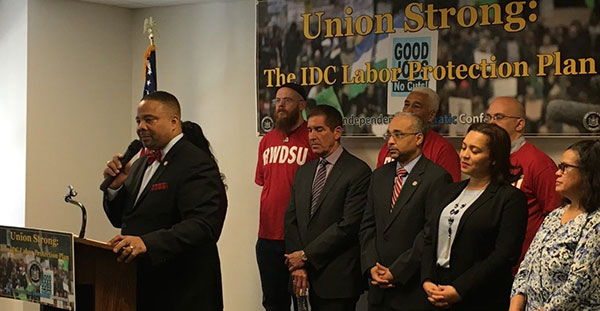
IDC members (photo: @IDC4NY)
For years, dysfunction and real estate power brokers have prevented Albany from strengthening tenant protections in New York, and the result of these failures has been devastating for our neighborhoods: we continue to suffer from record homelessness and increasing displacement across the state.
The Independent Democratic Conference — a group of eight breakaway state senators elected as Democrats — has been a leading force of obstruction since 2011, partnering with Senate Republicans to shut out tenant voices in policy-making.
Recently, things began to look like they were changing in the Senate for the first time in years. The mainline Democrats and the IDC took up serious discussion about how to unify the conference. During the course of negotiations, the IDC claimed that its focus is “policies, not politics,” and outlined a series of key priorities for the conference.
We were extremely disappointed to learn that strengthening tenant protections was not one of them — especially since several members of the conference have both privately and publicly stated to us that this would be their top issue in 2018.
We are tenants and we are constituents of three IDC members: Senators Marisol Alcantara, Jose Peralta, and Jesse Hamilton. Joined together, these State Senators have the highest concentration of rent-regulated units in New York City.
We are fighting every day to be able to stay in our homes. Our neighborhoods are facing gentrification, and our landlords know loopholes in the rent laws mean they can raise our rents to market rate as soon as we leave. As a result, we face harassment, reduced services, and deplorable living conditions – all in an attempt to get us out of our homes. We have called on our state-level elected leaders to prioritize strengthening the rent laws through closing two major loopholes: the 20% eviction bonus and preferential rent. Our communities are experiencing increased rents, speculative landlords, and mass gentrification.
Over and over, Senators Alcantara, Hamilton, and Peralta told us that the IDC is the best vehicle to meet so-called progressive priorities. After serious pressure, they had committed to prioritizing these issues for the overwhelming number of tenants who live in their districts.
But once it came time to deliver, these senators and the IDC once again proved that they are the conference of the real estate industry. This is devastating for the tenants who are suffering in their districts daily because of laws that favor landlords.
In Peralta’s district, families at LeFrak City are sacrificing their savings, pulling their kids out of after-school programs, getting second jobs, and moving into smaller cramped apartments just to make ends meet. Many of us are seeing large rent hikes. At the end of every month, moving trucks haul the belongings of yet another family that has lost its apartment due to the preferential rent scam that Senator Peralta could fix next year.
In Brooklyn, just a few weeks ago, Senator Hamilton joined the Flatbush Tenants Coalition to tell the story of an 85-year-old grandmother recently evicted and now forced to live with friends on their couches, with her belongings in storage. Housing court in Brooklyn often has lines stretched around the block because the state ludicrously rewards landlords for evictions by allowing management to collect a 20% increase in rent — an eviction bonus.
The eviction bonus is the largest contributor to rent increases in rent-stabilized apartments. It doesn’t matter if the tenant moved out willingly or because the landlord refused to provide basic services to keep the apartment livable. The landlord can take that 20% increase, even if it raises the rent above market value.
Preferential rent is a bait-and-switch scam to get tenants out and collect the 20% eviction bonus. When a tenant first moves into an apartment, the landlord offers them a “discounted” rent. But when the lease is up, tenants can see increases of hundreds of dollars on their monthly rent.
This is simply a tactic used to get the eviction bonus and keep rents skyrocketing.
Preferential rents are causing tenants in Alcantara’s district to face potential increases of $1,000 or more when their lease expires, causing tenants to move and disrupting communities.
To be very clear, this can be changed through legislation in Albany.
Senators Alcantara, Hamilton, and Peralta could help change this next year. They have spent the past years and months promising tenants in their districts that this is a top priority. Alcantara and Peralta went as far as publishing their promises in an op-ed. But we have since seen that like so many things with IDC senators, these promises ring hollow, as the IDC did not list rent regulations as a priority area in its negotiations to realign with mainline Democrats.
There are only a few months left for the members of the IDC to deliver for tenants. If they fail to do so, we will remember in September.
***
Aisha Gomez is a resident of LeFrak City in Senator Jose Peralta’s district in Queens
Sherryann Bain is a resident of Flatbush in Senator Jesse Hamilton’s district in Brooklyn
Lauren Nye is a resident of Washington Heights in Senator Marisol Alcantara’s district in Manhattan
***
Have an op-ed idea or submission for Gotham Gazette? Email This email address is being protected from spambots. You need JavaScript enabled to view it.